PHILOSOPHY
PAPER – III
Note : This paper contains seventy five (75) objective type questions of two (2) marks each. All questions are compulsory.
1. The pen I am writing with according to Advaita is
(1) Sat
(2) Asat
(3) Both Sat and Asat
(4) Neither Sat nor Asat
2. Which one according to the Vaiśesikas is the asamavayikārna a of a pot ?
(1) Kapāla
(2) Kapāla-samyoga
(3) Upādāna
(4) Danda-samyoga
3. Select the code that states nitya mūrtadravyas only
(1) Ksiti , manas, ākāśá
(2) Dik, Kāla, ātmā
(3) Paramānus of Ksiti , teja and maruta
(4) Kāla, ātma and manas.
4. The absence (abhāva) of bitterness resides in sugar _____ by the relation of
(1) Samavāya
(2) Samyoga
(3) Viśesanatā
(4) Svarūpa
5. In case of a pot the stick of the potter is according to the Vaiśsikas :
(1) Samavāyikārana
(2) Asamavayikārana
(3) Nimittakārana
(4) Anyathāsiddha
6. The relation between jāti and vyakti according to Kumārila is
(1) Samavāya
(2) Tādātmya
(3) Svarūpa
(4) Samyoga
7. Which one of the following is true with reference to Leibnitz’s doctrine of pre-established Harmony ?
(1) Bodies and Souls work inconsonance with each other and become one.
(2) Bodies act as if there were no souls, and souls act as if there were no bodies, but both act as if one influenced the other.
(3) Bodies act on souls and souls act on bodies.
(4) Both bodies and souls are one and the same.
8. Consider the following statements with reference to Kant and mark the correct code :
(i) Space and Time are objective and exist in their own right.
(ii) Space and Time are not objective but only appearances and are relative.
(iii) Space and Time are a priori.
Codes :
(1) Only (ii) is true
(2) Only (i) and (ii) are true
(3) Only (iii) is true
(4) Only (i) and (iii) are true
9. Consider the following statements with reference to Descartes and mark the correct code :
(i) All Mental states are reducible to Physical states.
(ii) All Physical states are reducible to Mental states.
(iii) Body-Mind relation is not similar to that of Car and Driver.
(iv) There is no Corporeal and non-corporeal distinction with respect to human beings.
Codes :
(1) Only (iii) is true.
(2) Only (i) and (iv) are true
(3) Only (ii) and (iii) are true
(4) Only (ii), (iii) and (iv) are true
10. ‘It is impossible to realize perfect truth so long as we are imprisoned in the mortal frame’ is the view of
(1) K.C. Bhattacharya
(2) Radhakrishnan
(3) J. Krishnamurti
(4) Gandhi
11. Consider given Assertion (A) and Reason (R) in the light of Hume and mark the correct code.
Assertion (A) : Personal identity is the work of imagination.
Reason (R) : The succession of pleasure-pain, sensations and images are connected together by resemblance, contiguity and causation.
Codes :
(1) Both (A) and (R) are true and (R) is the correct explanation of (A).
(2) Both (A) and (R) are true, but (R) is not the correct explanation of (A).
(3) (A) is true, but (R) is the false.
(4) (A) is false, but (R) is true.
12. Relation between word and its’ meaning is not natural is the view upheld by
(1) Bauddhas
(2) Vedāntins
(3) Mimāmsākas
(4) Naiyāyikās
13. Which of the following pair supports the view that Truth of Cognition has not to be verified by any other cognition ?
(1) Vedanta and Mimāmsa
(2) Mimāmsa and Sāmkhya
(3) Mimāmsa and Nyāya
(4) Vedānta and Nyāya
14. When the i plied meaning of a word or an expression excludes the primary meaning partially, then it is the case of
(1) Abhidhā
(2) Ajahat laksanā
(3) Jahat – Ajahat laksanā
(4) Vyañjanā
15. Match List-I with List-II and select the correct answer by using the codes below :


16. The negation of the non-cow is a positive entity and is different from the non-cow is the view appropriated by :
(1) Naigama Naya
(2) Apohavāda
(3) Pratibimbavāda
(4) Saptabhanginaya
17. ‘Pratyak am Kalpanāpodam’ this definition of pratyakşa was given by :
(1) Dinnāga
(2) Dharmakirti
(3) Gangeśa
(4) Īśvarakrsna
18. The nirvikalpaka state of pratyaksa is proved by the Naiyāyikas by
(1) Pratyaksa
(2) Anumāna
(3) Upamāna
(4) Sábda
19. ‘Yāga na svargahetuh kriyatrāt’ which type of hetvābhāsa is committed by the above anumāna ?
(1) Bādhita
(2) Satpratipaksa
(3) Viruddha
(4) Savyabhichāri
20. Self according to the Vaiśesikas cannot be the serlestratum of knowledge when it becomes
(1) Knower
(2) Known
(3) In bondage
(4) Liberated
21. It is through the mind that one sees, that one hears. Indeed, everything is perceived on being invested with the light of Buddhi like an object in the dark illumined by a lamp located in front of it, in the view of
(1) Gangeśa
(2) Śanikara
(3) Vallabha
(4) Kapila
22. Which list of purusārthas is acceptable to the Cārvākas ? Select the code given below :
(1) Artha and Kāma
(2) Artha, Kāma and Dharma
(3) Mok a and Kāma
(4) Kāma and Dharma
23. Which of the following is not a teaching of ‘Bhagvad gitā ?
(1) Renunciation of fruits of actions.
(2) Performance of ones natural and appointed duties.
(3) Elevation at good fortune and depression at loss should be conquered.
(4) All egoistic desires should not be directed to God.
24. Which of the following does not belong to the group of Brahmavihāra ?
(1) Muditā
(2) Karunā
(3) Ekāgratā
(4) Maitri
25. Which of the following is not a Tri-ratna according to Jainism ?
(1) Samyak Bhāvanā
(2) Samyak Cāritra
(3) Samyak Darśana
(4) Samyak Jñāna
26. ‘Śabda nitya śabdatvāt’, which type of hetvābhāsa is committed by the above anumāna ?
(1) Sādhārana savyabhichāra
(2) Anupasamhāri
(3) Satpratipksa
(4) Asādhārana savyabhichāra
27. Find the equivalence by matching List-I with List-II and select the correct answer by using codes below :

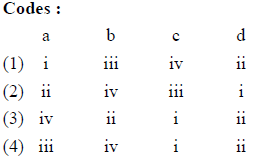
28. In the context of Traditional square of opposition of proposition, Match list-I with list-II and select the correct answer by choosing the codes given below :


29. Match the List-I with List-II and select the correct answer by using the codes below :


30. Set down the relation between universal and existential quantification by matching the List-I with List-II and select the appropriate code for your answer :


31. Which of the following abbreviated forms of, ‘Neither fill more nor Harding was the greatest President’, is correct ?
(1) (~ f) ⋅ (~ H)
(2) (~ F ∨ ~ H)
(3) F ∨ H
(4) ~ (F ⋅ H)
32. Match the List-I with List-II and select the correct answer by using the code given below :

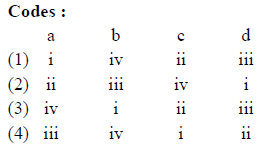
33. Consider the Assertion (A) and Reason (R) and select the correct code given below :
Assertion (A) : The number of distributed terms in the conclusion must be at least one less than the total number of distributed terms in the premises.
Reason (R) : The middle term does not appear in the conclusion.
Select the correct answer from the codes given below :
Codes :
(1) (A) and (R) both are true and (R) is the correct explanation of (A).
(2) (A) and (R) both are true, but (R) is not the correct explanation of (A).
(3) (A) is false and (R) is the true.
(4) Both (A) and (R) are false.
34. Consider the Assertion (A) and Reason (R) and select the correct code given below :
Assertion (A) : If one Premise is particular, the conclusion must be particular.
Reason (R) : (i) An affirmative particular has no distributed terms, and a negative particular has only one.
(ii) The premises cannot both be particular and thus must differ in quantity.
Codes :
(1) (A) and (R) both are true and (R) (i), (ii) correctly explain of (A).
(2) (A) and (R) both are true, but (R) (i) is a correct explanation of (A).
(3) (A) and (R) both are true and (R) (ii) is a correct explanation of (A).
(4) (A) is true, but (R) (i) and (ii) are incorrect explanations of (A).
35. “If a language is provided with a truth definition, that is sufficient condition of its concept of truth” – is advocated by
(1) Correspondence theory of truth
(2) Redundance theory of truth
(3) Semantic theory of truth
(4) Pragmatic theory of truth
36. Who among the following is not a sceptic ?
(1) Hume
(2) Pyrrho
(3) Bayle
(4) Descartes
37. What is the criterion of truth according to Descartes ?
(1) Clearness and uniformity
(2) Clearness and distinctness
(3) Clearness and completeness
(4) Clearness and directness
38. Which one of the following pair does not match correctly with reference to Leibnitz ?
(1) Truths of Reason – necessarily true
(2) Truths of Fact – based on principle of sufficient reason.
(3) Truths of Reason – based on Law of Contraction.
(4) Truths of Fact – cannot be denied without contradiction.
39. “Ideas are of two kinds; ideas imprinted on the senses and ideas formed by memory and imagination.” ____ is the view advocated by;
(1) Locke
(2) Berkeley
(3) Hume
(4) Leibnitz
40. Consider the following statements with reference to Locke’s theory of knowledge and mark the correct code :
(i) knowledge depends on the mental power to perceive or apprehend ideas.
(ii) knowledge is not rational.
(iii) knowledge consists in seeing the agreement or disagreement between ideas.
Codes :
(1) Only (i) is true.
(2) Only (ii) is true
(3) Only (i) and (iii) are true.
(4) Only (i) and (ii) are true
41. Which one of the following is not correct about ‘Sthitaprajña’ of Bhagavadgita ?
(1) A ‘Sthitaprajña’discards are desires from his mind.
(2) A ‘Sthitaprajña’is not disturbed in suffering.
(3) ‘Sthitaprajña’is not desirous of pleasure.
(4) ‘Sthitaprajña’ always thinks to do good for others.
42. Given below are two statements, one labelled as Assertion (A) and the other labelled as Reason (R). Considering (A) and (R), select the correct code :
Assertion (A) : Kant’s ethics of categorical imperative is formal and regoristic.
Reason (R) : It disparages the role of sensibility.
Codes :
(1) Both (A) and (R) are true and (R) is the correct explanation of (A).
(2) Both (A) and (R) are true, but (R) is not the correct explanation of (A).
(3) (A) is true, but (R) is the false.
(4) (A) is false, but (R) is true.
43. Match List-I with List-II and select the correct answer by using codes given below :


44. It has been pointed out that the Mill’s argument for Refined altruistic Hedonism suffers from the fallacy. Select the correct answer from the given below :
(1) Illicit major
(2) Illicit minor
(3) Undistributed middle
(4) Fallacy of figure of speech
45. The aim of deterrent theory of punishment is
(1) To take revenge from the crime done
(2) To prevent future act of crime
(3) To reform the criminal
(4) To assert the autonomy of individual
46. How would a normative ethicist explain the statement ‘This is good’ ?
(1) ‘This’ is the end of life
(2) ‘This’ is approved by people in General
(3) I approve ‘this’
(4) do ‘this’
47. Which one of the following expresses the basis tenet of hedonism ?
(1) Honesty is good in itself.
(2) Honesty is good because it promotes happiness.
(3) Honesty is good because it is a natural capacity of man.
(4) Honesty is good because it distinguishes man from beast.
48. Match List-I with List-II and select the correct answer by using codes given below :

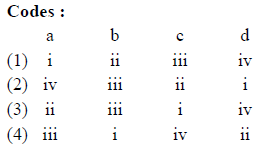
49. Match List-I with List-II and select the correct answer by using codes given below :

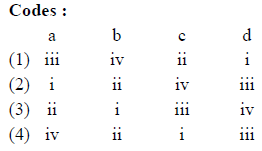
50. ‘Good’ according to Moore is indefinable because
(1) It has innumerable qualities
(2) It is a simple term
(3) It is a super sensible thing
(4) It is a meaningless term
51. Who among the following pairs of Vedāntins, do not justify the concept of Jivanmukti ?
(1) Śankara and Rāmānuja
(2) Rāmānuja and Madhva
(3) Śankara and Madhva
(4) Vācaspati and Prakāśātman
52. Who among the Pūrva-mimāmsins hold the view that Dharma is only an intrinsic value and not instrumental ?
(1) Kumārila
(2) Prabhākara
(3) Śabara
(4) Murāri Miśra
53. With reference to Patanjali’s Yogadarśana, select the correct sequence.
(1) Niyama, yama, prānāyāma , āsana, pratyāhāra
(2) Yama, niyama, pranāyāma , āsana, pratyāhāra
(3) Yama, niyama, āsana, prānāyāma , pratyāhāra
(4) Āsana, prānāyāma pratyāhāra, yama, niyama
54. Match List-I with List-II and select the correct with the help of the codes given below :
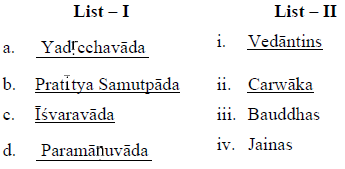

55. Match List-I with List-II and select the correct answer with the help of codes given below :


56. Who among the Indian Philosophers makes a distinction between Dharmabhūtajñāna and Dharm bhūtajñāna ?
(1) Vasubandhu
(2) Madhva
(3) Rāmānuja
(4) Vallabha
57. “Whose among the following is the philosophy of bhedābheda ?
(1) Citsukha
(2) Kundakunda
(3) Jaimini
(4) Nimbārka
58. Who among the following philosophers advocate Avikrta parināmavāda ?
(1) Nimbārka
(2) Śankara
(3) Vallabha
(4) Madhva
59. Match List-I with List-II and choose the correct answer with the help of codes given below :


60. Which religion amongst the following advocates fire worship ?
(1) Judaism
(2) Christianity
(3) Islam
(4) Zorastrianism
61. Consider given Assertion (A) and Reason (R) and then mark the correct option as given below
Assertion (A) : Gandhi accepted ‘Satyāgraha’ as a weapon to fight the British Empire.
Reason (R) : He was afraid of British rulers.
Codes :
(1) (A) and (R) both are true and (R) is the correct explanation of (A).
(2) (A) and (R) both are true, but (R) is not the correct explanation of (A).
(3) (A) is true, but (R) is false.
(4) (A) is false, but (R) is true.
62. Which one of the following statements is true with reference to Eco-feminism ?
(1) It identifies culture with female and nature with male and questions the dominance of female.
(2) It identifies culture with male and nature with female and questions the dominance of male.
(3) It identifies culture with male and nature with female and questions the dominance of female.
(4) It identifies culture with female and nature with male and questions the dominance of male.
63. Who among the following philosophers held the view that “A natural right is a son that never had a father’?
(1) Edmurd Burke
(2) Bentham
(3) Nietzsche
(4) Mac Intyre
64. Which one of the following is not correct about Gandhian ethics ?
(1) Truth as the end
(2) Non-Violence as the means
(3) Both the end means should be just
(4) A Just end justifies the bad means
65. Match List-I with List-II and select the correct answer by using codes given below :

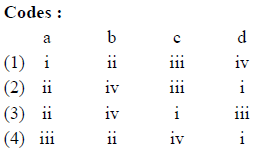
66. “I will kill you” is an example of which one of the following speech Acts according to Austin ?
(1) Locutionary
(2) Illocutionary
(3) Perlocutionary
(4) Non-locutionary
67. Which one of the following lists correctly depicts Austin’s division of verbs that differ in their illocutionary force ?
(1) Verdictives exercitives commissives, behavitives and expositives.
(2) Verdictives, exercitives, commissives, syntactical and expositives.
(3) Verdictives, exercitives, commissives, semantical and behavitives.
(4) Verdictives, exercitives, semantical, syntactical and commissives.
68. “To be is to be the value of a variable” is the standpoint advocated by
(1) Quine
(2) Frege
(3) Russell
(4) Strawson
69. Which one of the following cannot be considered as indefinite description as per Russell ?
(1) Present king of Ayodhya
(2) Present President of India
(3) Present Governor of Reserve Bank of India
(4) Present Prime Minister of India.
70. “There is no one standard meaning of a given word, it has as many meanings as it has uses, and that these are countless.” – is the view held by :
(1) Russell
(2) Frege
(3) Wittgenstein
(4) Dammett
71. “Death destroys all our possibilities” is the statement of
(1) Heideggar
(2) Husserl
(3) Sartre
(4) Jaspers
72. According to which one of the following ‘essences’ can be ‘seen’ just as ‘tones’ can be ‘heard’.
(1) Heideggar
(2) Marcel
(3) Husserl
(4) Satre
73. Which one of the following is not the aim of Husserl’s phenomenology ?
(1) To discover the foundations of knowledge and experience.
(2) To lay bare the structure which constitutes the essences of logical concepts.
(3) To take neutral position with respect to the states of consciousness.
(4) To accept the presuppositions of a given systems.
74. Match List-I with List-II and mark the correct code :

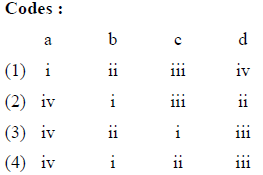
75. Which one of the following philosophers Contributed ‘Ontological turn’ to Hermeneutics.
(1) Paul Ricoeur
(2) Derrida
(3) Habermas
(4) Heidegger
Latest Govt Job & Exam Updates: